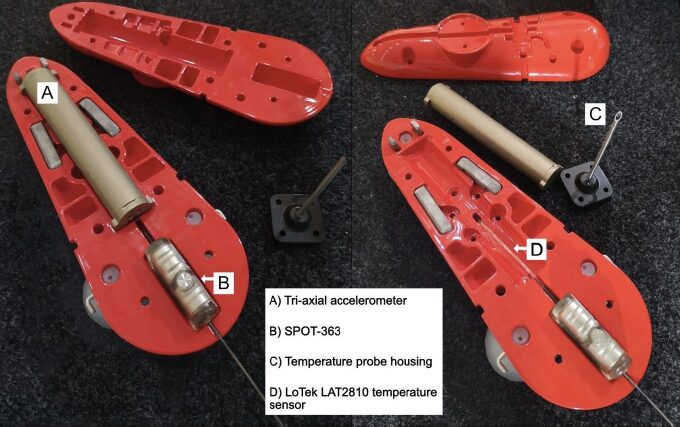Chasing Rays: A New Biologging Tag Unlocks the Mysteries of Devil Ray Movement
An important objective of this project is to investigate the influence of ambient temperature on the vertical distribution of sicklefin devil-rays, Mobula tarapacana. Understanding the influence of environmental temperature on the species 3-dimensional distribution is essential for developing conservation strategies that will remain effective in the face of changing ocean temperatures. To address this question, we developed a novel-biologging package (hereafter referred to as the Remora Tag) to record internal temperature, ambient temperature, 3-axial acceleration, and depth from free-swimming devil-rays in the Azores Archipelago.
In 2023, despite challenges with the deployment mechanism, we successfully collected the first-ever dataset on internal temperature for sicklefin devil rays—albeit a short one—which also represents the first instance of internal temperature data recorded for any moulid species. This was a monumental accomplishment, however in the winter of 2023, we worked with CEiiA to adjust the deployment/attachment mechanisms in hopes of obtaining more complete datasets in 2024.

Figure 1: A school of sicklefin devil-rays at Princess Alice Seamount containing an individual tagged with the Remora Tag. Photo © Sophie Prendergast
The Remora Tag houses three sensors, a tri-axial accelerometer (designed & manufactured by CEiiA), a LAT2810 sensor used to measure the animals internal and ambient temperature (produced by LoTek), and a SPOT-363 which is used to locate the tag once it releases from the animal (produced by Wildlife Computers; Fig 2). The accelerometer records the animals’ forward surge, horizontal sway, and pitch, similarly to the way a fit bit measures our movements. Additionally, the tag records the animal’s depth (meters). Due to the fragile nature of the LAT2810 internal temperature probe, we designed a needle-like metal probe to prevent the sensor from being crushed during deployment (Fig 2). The housing for the temperature probe also prevents the tag from sliding off the animal, since sicklefin devil-rays have a thick layer of mucus that coats their skin. Lastly, the SPOT-363 transmits the Remora Tag’s location once it is released from the animal which allows us to recover it, download the data, and redeploy it another individual (Fig 2).

Figure 2: The Remora Tag interior and sensors. Image © CEiiA
The tag is deployed by free diving using a specially designed pole that attaches to the tag with magnets. The free diver must swim down towards the animal and press the tag onto its body so that the temperature probe is in the muscle and the suction cups are firmly attached. The force of the animal swimming forward releases the tag from the pole and voit la the Remora Tag has been deployed! The suction cups are held in place by plastic tubes that are pinched shut using a galvanic link (metal that reacts with seawater and dissolves at a predetermined rate). Once the galvanic link fully dissolves the tubes open allowing water to flood the suction cups and release it from the devil-ray. Check out the video below to see the full deployment process!
We are thrilled to report that our modifications were successful, and we were able to complete multiple 72h deployments of the Remora Tag on free-swimming sicklefin devil-rays! Analysis of this data will offer critical insights into the species’ physiology, particularly their thermoregulatory capabilities, thereby providing a deeper understanding of how environmental temperatures influences their distribution within a three-dimensional habitat. The simultaneous collection of acceleration and depth data provides further detail regarding the species activity level as they interact with their surroundings which can be used to shed light on the ecological purpose of specific observed behaviours, such as repeated dives (up to 1,800 meters) to the bathypelagic zone (Thorrold et al., 2014).
**References:
Thorrold, S. R., Afonso, P., Fontes, J., Braun, C. D., Santos, R. S., Skomal, G. B., & Berumen, M. L. (2014). Extreme diving behaviour in devil rays links surface waters and the deep ocean. Nature communications, 5(1), 4274.
